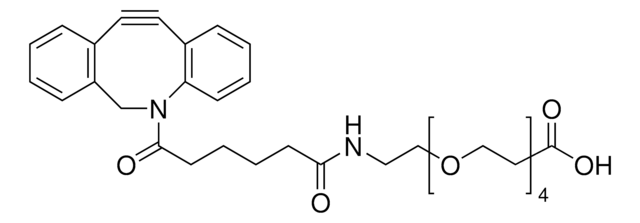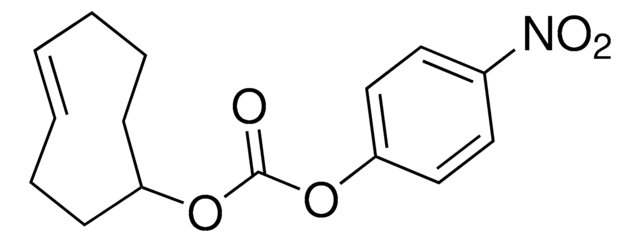추천 제품
형태
solid
반응 적합성
reaction type: click chemistry
reagent type: linker
mp
50-60 °C
작용기
hydroxyl
저장 온도
−20°C
SMILES string
O=C(CCCCC(NCCOCCOCCOCCOCCO)=O)N1CC2=C(C=CC=C2)C#CC3=C1C=CC=C3
InChI
1S/C29H36N2O6/c32-16-18-36-20-22-37-21-19-35-17-15-30-28(33)11-5-6-12-29(34)31-23-26-9-2-1-7-24(26)13-14-25-8-3-4-10-27(25)31/h1-4,7-10,32H,5-6,11-12,15-23H2,(H,30,33)
InChI key
ZZXWONCQAFVJHM-UHFFFAOYSA-N
애플리케이션
Alcohol functionalized cyclooctyne derivative. Cyclooctynes are useful in strain-promoted copper-free azide-alkyne cycloaddition reactions. This dibenzocyclooctyne will react with azide functionalized compounds or biomolecules without the need for a Cu(I) catalyst to result in a stable triazole linkage. The PEG spacer adds hydrophilicity to the product to decrease aggregation.
Storage Class Code
11 - Combustible Solids
WGK
WGK 3
Flash Point (°F)
Not applicable
Flash Point (°C)
Not applicable
시험 성적서(COA)
제품의 로트/배치 번호를 입력하여 시험 성적서(COA)을 검색하십시오. 로트 및 배치 번호는 제품 라벨에 있는 ‘로트’ 또는 ‘배치’라는 용어 뒤에서 찾을 수 있습니다.
이미 열람한 고객
Nicholas J Agard et al.
ACS chemical biology, 1(10), 644-648 (2006-12-19)
Detection of metabolites and post-translational modifications can be achieved using the azide as a bioorthogonal chemical reporter. Once introduced into target biomolecules, either metabolically or through chemical modification, the azide can be tagged with probes using one of three highly
Visualizing metabolically labeled glycoconjugates of living cells by copper-free and fast huisgen cycloadditions.
Xinghai Ning et al.
Angewandte Chemie (International ed. in English), 47(12), 2253-2255 (2008-02-16)
John C Jewett et al.
Journal of the American Chemical Society, 132(11), 3688-3690 (2010-03-02)
Bioorthogonal chemical reactions, those that do not interact or interfere with biology, have allowed for exploration of numerous biological processes that were previously difficult to study. The reaction of azides with strained alkynes, such as cyclooctynes, readily forms a triazole
Jeremy M Baskin et al.
Proceedings of the National Academy of Sciences of the United States of America, 104(43), 16793-16797 (2007-10-19)
Dynamic imaging of proteins in live cells is routinely performed by using genetically encoded reporters, an approach that cannot be extended to other classes of biomolecules such as glycans and lipids. Here, we report a Cu-free variant of click chemistry
문서
Copper-free click chemistry is an alternative approach to click chemistry that proceeds at a lower activation barrier and is free of cytotoxic transition metal catalysts.
자사의 과학자팀은 생명 과학, 재료 과학, 화학 합성, 크로마토그래피, 분석 및 기타 많은 영역을 포함한 모든 과학 분야에 경험이 있습니다..
고객지원팀으로 연락바랍니다.










![N-[(1R,8S,9s)-Bicyclo[6.1.0]non-4-yn-9-ylmethyloxycarbonyl]-1,8-diamino-3,6-dioxaoctane for Copper-free Click Chemistry](/deepweb/assets/sigmaaldrich/product/structures/294/853/c5e47d84-5aee-4797-aa24-604f291171cc/640/c5e47d84-5aee-4797-aa24-604f291171cc.png)


![(1R,8S,9s)-Bicyclo[6.1.0]non-4-yn-9-ylmethanol for Copper-free Click Chemistry](/deepweb/assets/sigmaaldrich/product/structures/171/632/0556139a-2db5-4678-a6ec-a26a693fd574/640/0556139a-2db5-4678-a6ec-a26a693fd574.png)

